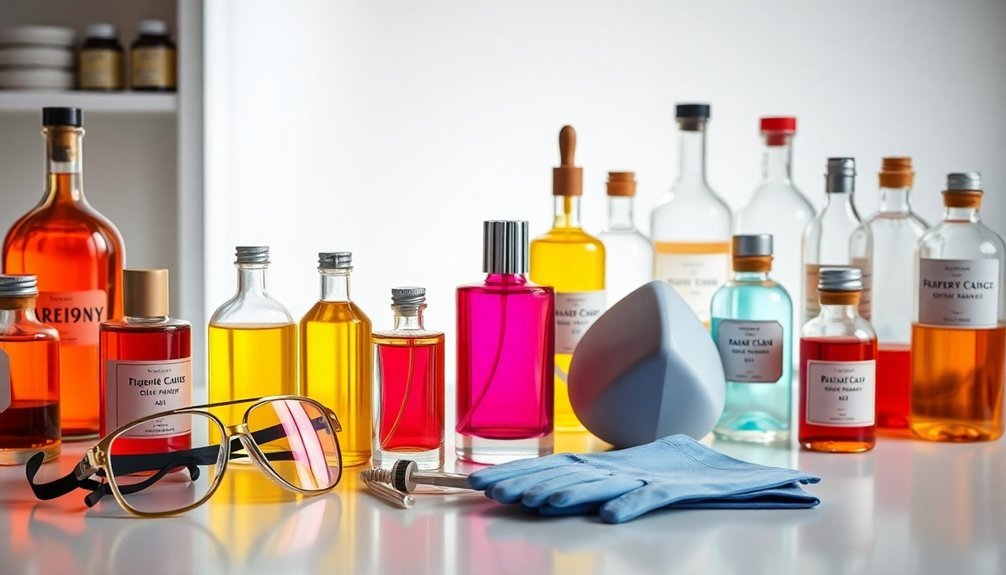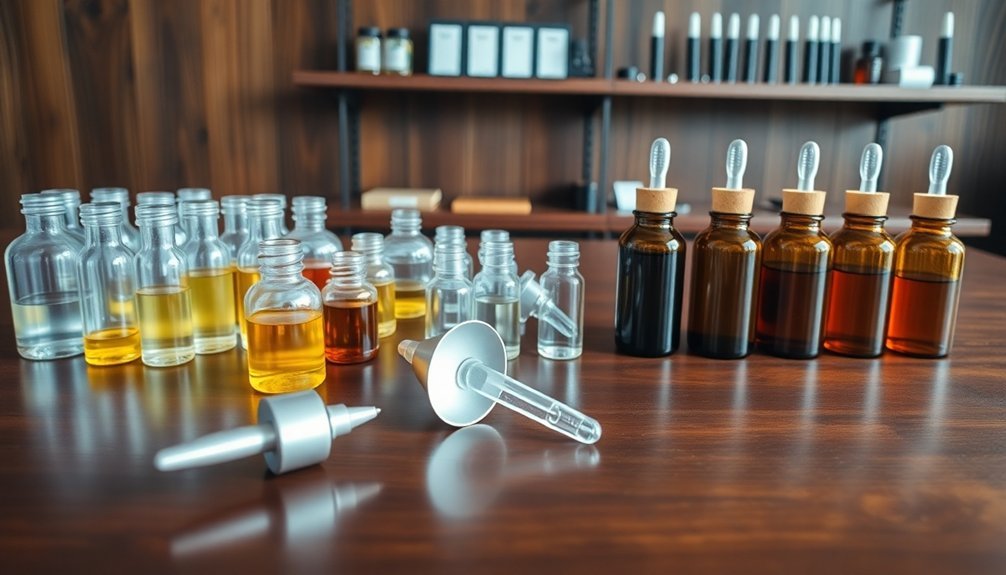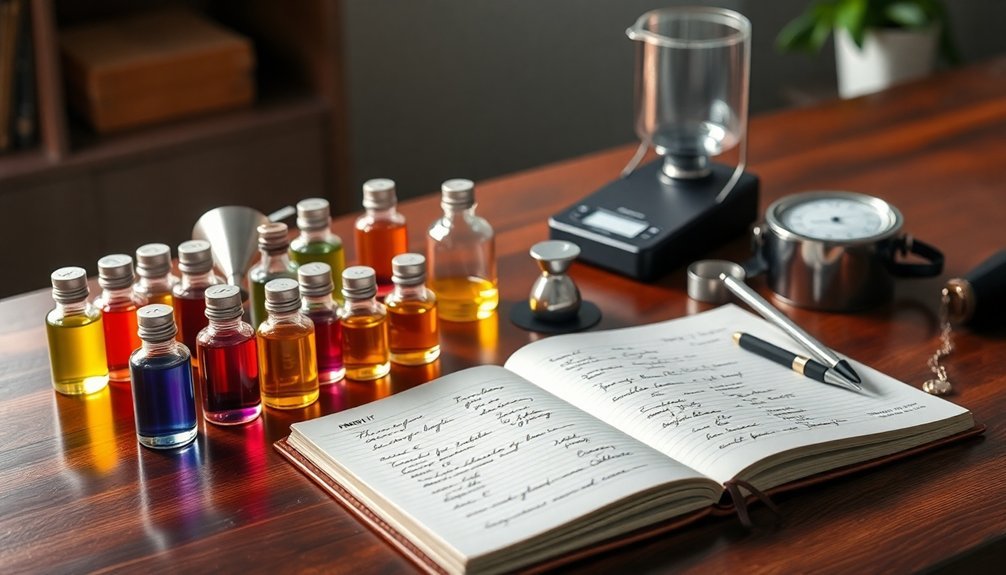To create perfumes at home, you'll need essential safety gear (gloves, goggles, masks), precise measuring tools (digital scale, droppers, funnels), and quality storage containers (dark glass bottles). Stock up on fragrance components like essential oils or synthetic scents, plus carrier solutions such as alcohol or oils. Don't forget documentation supplies for recording formulas and aging logs. Your complete kit should also include cleaning tools and packaging materials. Let's explore each component in detail to help you craft stunning fragrances.
Essential Equipment for Your Perfume Workshop

Every successful perfume workshop requires a well-organized foundation of essential equipment and supplies.
You'll need a stable workspace with a sturdy table or desk and a comfortable, adjustable chair where you can blend your creations. Keep your aromatics safely stored in a dedicated cabinet or drawer system.
For your safety, don't skip the protective gear – safety goggles and nitrile gloves are must-haves. Keep accurate records using three-ring binders to organize your formulas and notes.
You'll also need bottle cleaning brushes and vodka for sanitizing your equipment. Essential ingredients include high-proof alcohol like Everclear, your choice of essential or fragrance oils, and glycerine.
Stock up on scent strips and holders for testing your blends, and consider adding a bain-marie for warming aromatics. A timer will help you track your fragrance experiments effectively.
Basic Measuring Tools and Containers
The art of perfume making demands precise measurements and proper storage to achieve consistent results.
You'll need a digital scale that measures to 0.00 grams and glass measuring cylinders for accurate liquid measurements. Testing strips provide a method to validate scent profiles without interference from skin chemistry. Borosilicate beakers are ideal for dilutions, while a thermometer guarantees temperature control when needed.
For blending and storage, you'll want small glass or ceramic bowls and dark glass containers to protect your fragrances from light degradation.
Don't forget essential tools like glass funnels with filter papers to remove impurities, and pipettes or droppers for precise oil measurements.
Stainless steel tools, including bowls and strainers, offer durability and non-reactive properties.
Remember to sterilize all measuring equipment with ethanol before use to maintain the purity of your perfumes.
Safety Gear and Protective Equipment

Safe perfume making requires essential protective gear to shield you from potential hazards.
You'll need chemical-resistant gloves, preferably made of nitrile, to protect your hands when handling fragrances and oils. Safety goggles are vital to prevent eye exposure to splashes, while a face mask or respirator will protect you from inhaling strong fumes.
Don't forget to wear a lab coat or apron to protect your clothing and skin, and always wear closed-toe shoes in your workspace. Ensure you inspect PPE regularly for any signs of wear or damage.
Set up your perfume-making station in a well-ventilated area with proper airflow – open windows and use exhaust fans when necessary. Keep your safety data sheets handy and store your chemicals properly in labeled containers.
Have a spill kit and fire extinguisher nearby for emergencies.
Natural and Synthetic Fragrance Components
You'll encounter both essential oils and synthetic fragrances in your perfume making journey, with each offering unique benefits for your creations.
Today's fragrance classification systems help you understand how different scents work together, whether you're using natural florals, synthetic musks, or a combination of both.
When working with either type, you'll need to contemplate their solubility in alcohol bases, as this affects how well they blend and how long your perfume will last.
Essential Oils Vs Synthetics
When creating your own perfumes, understanding the distinction between essential oils and synthetic fragrances becomes essential for achieving your desired results.
Essential oils deliver natural scents and therapeutic benefits directly from plants, while synthetic fragrances are lab-created alternatives that often provide stronger, longer-lasting aromas at a lower cost.
You'll find that essential oils work best for aromatherapy and wellness-focused perfumes, while synthetic options allow for unique scent combinations that don't exist in nature.
- Natural essential oils promote physical and emotional well-being
- Synthetic fragrances offer more potent and diverse scent options
- Essential oils have fewer skin reaction risks than synthetics
- Lab-created fragrances are more cost-effective
- Natural oils maintain better stability without added preservatives
Consider your project's purpose when choosing between these options, as each brings distinct advantages to your perfume-making journey.
Fragrance Classification Systems
Understanding fragrance classification systems is essential for creating well-balanced perfumes.
You'll need to know three main classifications: concentration levels, fragrance notes, and fragrance families.
Concentration levels range from Eau Fraîche (1-3% oils) to pure Parfum (20-30% oils), affecting how long your scent will last.
When composing your perfume, you'll work with three note levels: top notes like citrus that last 15-30 minutes, heart notes like florals that persist for hours, and base notes like woods that provide long-lasting depth.
Your fragrance family choice will guide your ingredient selection.
You can work with floral (rose, jasmine), oriental (vanilla, amber), woody, chypre (bergamot, oakmoss), or fougère (lavender, geranium) families.
Modern perfumery also includes hybrid categories like floral oriental and fresh floral.
Solubility in Alcohol Bases
Alcohol serves as the foundation of most perfume formulations, playing an essential role in dissolving both natural and synthetic fragrance components.
You'll find that ethanol's polar molecules effectively blend fragrance oils while preventing separation, ensuring your perfume maintains a uniform consistency.
When you're creating custom blends, alcohol's rapid evaporation helps disperse the scent while extending the fragrance's longevity.
- Dissolves essential oils and synthetic fragrances uniformly
- Prevents oil separation and maintains homogeneous mixture
- Slows down fragrance oil evaporation for longer-lasting scents
- Aids in the gradual release of aromatic compounds
- Helps fragrance oils penetrate the skin effectively
Consider your skin's sensitivity when working with alcohol bases.
While it's excellent for fragrance dispersion, you might want to balance it with carrier oils if you have sensitive skin to minimize potential drying effects.
Carrier Solutions and Base Materials
In your perfume-making journey, you'll need to choose between carrier oils like jojoba and sweet almond, or alcohol bases such as ethanol and SD alcohol, as your foundation.
You'll find that carrier oils offer skin-friendly benefits and work perfectly for roll-on applications, while alcohol bases excel in spray perfumes and provide quick evaporation.
Your choice of carrier will greatly impact how your fragrance performs, with oils providing longer-lasting scents and alcohol bases offering better projection and diffusion.
Essential Carrier Solutions Explained
Carrier solutions serve as the foundation of any successful perfume creation, acting as the vital bridge between concentrated essential oils and your skin.
You'll need to choose your carrier oil based on your skin type and desired fragrance profile. When creating your perfume, you'll want to maintain a ratio of 15-30 drops of essential oil per ounce of carrier oil.
- Jojoba oil mimics your skin's natural oils and maintains fragrance stability
- Sweet almond oil works perfectly for sensitive skin with its gentle properties
- Fractionated coconut oil stays liquid and provides excellent blending capabilities
- Grapeseed oil's neutral scent lets your essential oils shine through
- Apricot kernel oil's silky texture helps fragrances last longer on your skin
Let your blends mature for several weeks in a cool, dark place to achieve the best results.
Understanding Alcohol Base Types
The foundation of every successful perfume lies in selecting the right alcohol base, with perfumers' alcohol being the gold standard for fragrance creation.
You'll find two main options: denatured and undenatured ethanol. While denatured alcohol is cheaper, it contains additives that can irritate sensitive skin.
For the best results, you'll want to use pure, undenatured perfumers' alcohol. It evaporates quickly, carries fragrances effectively, and won't alter your scent profile.
When mixing your perfume, stick to a ratio of 10-30% fragrance oils to alcohol, depending on your desired strength. For example, use 3ml of fragrance to 30ml of alcohol for a 10% concentration.
Always check your fragrance oils' IFRA certificates to guarantee you're not exceeding safe usage limits.
Natural Base Ingredients Guide
Selecting natural base ingredients forms the cornerstone of creating safe, effective perfumes.
You'll find carrier oils serve as the perfect foundation, with jojoba oil standing out for its skin-like properties and exceptional stability.
Sweet almond oil and fractionated coconut oil offer lightweight alternatives that blend seamlessly with essential oils, while apricot kernel oil adds a silky texture perfect for floral fragrances.
- Choose jojoba oil for its odorless nature and long shelf life
- Mix sweet almond oil when working with delicate floral scents
- Use fractionated coconut oil for roll-on perfumes that stay liquid
- Select apricot kernel oil to enhance absorption and skin benefits
- Combine different carrier oils to create unique base blends that match your fragrance goals
Blending and Testing Supplies
Creating your perfect fragrance requires essential blending and testing tools to achieve professional results.
You'll need a fragrance funnel, six droppers for precise measurements, and a 1 oz refillable bottle with a pump and customizable label for your blends.
For testing, use pH-neutral absorbent cards to evaluate your fragrances' top, middle, and base notes over time. You can apply scents by spraying, dropping, or dipping these strips.
Aerosol blotters, measuring 5" x 3", work best for testing perfume sprays – just remember to label the paddle end and test in a well-ventilated area.
If you're looking for advanced options, consider automated testing devices like PaperscentTM, which dispenses pre-scented strips and prevents fragrance mixing while tracking your testing data digitally.
Storage and Preservation Equipment

Your perfume making kit needs dark glass bottles with airtight caps to shield your creations from harmful UV rays and oxidation.
You'll want a storage box or cabinet that maintains consistent temperatures between 60-70°F to protect your fragrances from degradation.
Consider including acid-free tissue paper or protective wrapping materials to safeguard bottles during storage and transport.
Dark Glass Storage Containers
Dark glass storage containers serve as essential guardians of your precious perfume creations, offering critical protection against UV rays and environmental factors that can degrade your fragrances.
You'll want to invest in high-quality amber or cobalt glass bottles with airtight seals to preserve your scents' integrity. These containers not only protect against light damage but also prevent oxidation and maintain consistent humidity levels for your perfume oils.
- Small bottles (15-30ml) with screw-top caps for individual fragrances
- Amber or cobalt glass to block harmful UV rays
- Airtight seals to prevent oxidation and maintain freshness
- Durable construction that resists scratches and discoloration
- Elegant design that adds a professional touch to your creations
Store your bottles in a cool, dark place, avoiding bathrooms or areas with temperature fluctuations.
They'll help maintain your perfumes' original scent profiles for longer periods.
Temperature Control Equipment
Beyond proper storage containers, maintaining the right temperature plays a major role in preserving your perfume creations.
You'll need a reliable chilling system that can maintain temperatures down to -15 degrees Celsius, equipped with high-quality compressors for consistent cooling.
Your setup should include stainless steel evaporating coils integrated into mixing tanks. These coils work with chillers to cool your perfume mixture while helping filter out impurities.
For safety and precision, you'll want a monitoring system with displays and alarms that protect against overvoltage and overload.
Don't forget the filtration components – you'll need microporous membrane filters (0.2 to 1 micrometers) and anti-corrosion pneumatic pumps.
These guarantee your perfume stays pure through continuous circulation while maintaining ideal temperature control.
Protective Wrapping Materials
Professional perfume storage demands reliable protective wrapping materials to safeguard your valuable creations.
You'll need a combination of cushioning materials and leak prevention solutions to protect your perfumes during storage and transport. Start with foam inserts for custom fitting, and consider eco-friendly options like recycled paper or biodegradable plastics to maintain sustainability in your craft.
- Double-seal your bottles in plastic bags to prevent leaks and protect neighboring items
- Use corrugated boxes with internal padding for maximum shock absorption
- Add foam inserts that conform to your bottle shapes for a snug, secure fit
- Incorporate bubble wrap for flexible, easy-to-apply protection
- Select sustainable packaging materials like recycled cardboard or plant-based tapes for environmentally conscious storage
Workspace Organization Essentials

Creating an efficient workspace is vital for successful perfume making, as a well-organized setup can dramatically improve your blending process and creative flow.
Position your perfumery scale at the center of your workstation, as it's your most important tool. Set up tiered shelves behind your workspace to store raw materials alphabetically, and use clear storage bins to keep your ingredients visible and accessible.
You'll want to designate separate areas for your predilutions, blending materials, and final perfumes. Keep your scent strips in holders or jars near your evaluation area, and organize your drawers by ingredient types – powders, solids, middle notes, and bases.
Don't forget to arrange your dark glass bottles, spatulas, and pipettes within arm's reach. This setup guarantees you'll maintain a smooth workflow while crafting your fragrances.
Cleaning and Maintenance Tools
Maintaining pristine equipment is the cornerstone of quality perfume making. You'll need both cleaning agents and specialized tools to keep your supplies in top condition.
Isopropyl alcohol is your primary cleaning solution, though ethanol works well for deodorizing stubborn scents. For thorough cleaning, soak items in your chosen solution, scrub with appropriate brushes, and rinse with warm water.
- Glass measuring tools that resist odor absorption
- Specialized brushes for pipettes, funnels, and measuring equipment
- Isopropyl alcohol or ethanol for deep cleaning and deodorizing
- Protective gear including disposable gloves and safety glasses
- Soft cloths and cleaning brushes for thorough scrubbing
Remember to clean your equipment immediately after use and store everything in a well-ventilated area.
Regular maintenance prevents cross-contamination and guarantees the purity of your future creations.
Documentation and Formula Recording Materials

Accurate record-keeping forms the foundation of successful perfume making, allowing you to replicate your successes and learn from your experiments.
You'll need basic supplies like notebooks, pens, and sticky notes for daily documentation, along with pre-designed templates for systematic formula recording.
Essential measurement tools include digital scales, droppers, and conversion charts to guarantee precise calculations.
Keep your records organized in binders with labeled sections for recipes, scent profiles, and batch tracking sheets.
Don't forget to maintain aging logs to monitor how your fragrances evolve over time.
For reference, stock up on ingredient guides and fragrance notes resources.
These will help you understand the properties of different materials and how they interact.
You'll also want to keep industry standards and safety regulations readily accessible for compliance.
Bottling and Packaging Supplies
While selecting the right bottling and packaging supplies can seem overwhelming, you'll need a strategic mix of containers and presentation materials to protect and showcase your perfumes.
Start with high-quality glass bottles for their elegance and ability to preserve fragrances, and complement them with sturdy cardboard boxes featuring custom inserts for protection.
You'll find that eco-friendly options like bamboo containers or biodegradable plastics can set your creations apart while appealing to environmentally conscious customers.
- Small glass bottles with secure caps or sprayers for your finished perfumes
- Decorative boxes with foam or velvet inserts to cradle bottles safely
- Cellophane wraps or specialty paper for an elegant finishing touch
- Custom labels and packaging accessories like ribbons or magnetic closures
- Sample-size containers for testing and promotional purposes
Frequently Asked Questions
How Long Does Homemade Perfume Typically Last Before the Scent Starts Fading?
Your homemade perfume will typically last 3-5 years if it's alcohol-based and about a year if it's oil-based. You'll notice it's time to replace it when the scent becomes weak or changes noticeably.
Can I Create Perfumes Using Only Essential Oils Without Alcohol?
Yes, you can create alcohol-free perfumes using essential oils mixed with carrier oils. You'll need to dilute your essential oils properly with jojoba, coconut, or almond oil for safe skin application.
What's the Ideal Ratio of Fragrance Oils to Carrier Solution?
You'll want to start with a 20% fragrance oil to 80% carrier oil ratio. This means for every 100 drops, use 20 drops of fragrance oils and 80 drops of carrier solution.
How Can I Fix a Perfume Mixture That Smells Too Strong?
You can dilute your strong perfume by adding more carrier solution, using rubbing alcohol on application spots, or applying heat with a hair dryer. For clothes, try baking soda paste or alcohol wipes.
Which Essential Oil Combinations Should Be Avoided When Making Perfume?
You'll want to avoid mixing Peppermint with Lemon, Thyme, or Jasmine. Don't combine Orange with Lemon, or Grapefruit with Lemon. These combinations can cause skin irritation and unpleasant scents.
In Summary
Now you're ready to begin your perfume-making journey. With your complete kit assembled, you'll have everything needed to create unique fragrances safely and professionally. Remember to maintain detailed records of your formulas, keep your workspace organized, and always prioritize safety. Don't forget to regularly clean your equipment and store your materials properly. Start small, experiment confidently, and let your creativity guide your perfume-making adventure.





Leave a Reply